Fantasia 2016, Day 11 ,Part 1: Fragmentation and Fistfighting (Holy Flame of the Martial World and the Fragments of Asia 2016 Short Film Showcase)
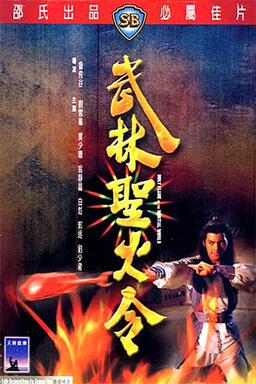 I’d marked four screenings on the Fantasia schedule to attend on Sunday, July 24. The first two were both at the small De Sève Theatre: a presentation of the 1983 Shaw Brothers film Holy Flame of the Martial World (Wu lin sheng huo jin), followed by a short film showcase. The showcase, Fragments of Asia 2016, promised half-a-dozen pieces from across Asia, both animated and live-action. Afterward I’d have time for food, and then two more movies would follow. Before all that, though, came one of the films I’d immediately highlighted when I first saw what was playing at this year’s Fantasia.
I’d marked four screenings on the Fantasia schedule to attend on Sunday, July 24. The first two were both at the small De Sève Theatre: a presentation of the 1983 Shaw Brothers film Holy Flame of the Martial World (Wu lin sheng huo jin), followed by a short film showcase. The showcase, Fragments of Asia 2016, promised half-a-dozen pieces from across Asia, both animated and live-action. Afterward I’d have time for food, and then two more movies would follow. Before all that, though, came one of the films I’d immediately highlighted when I first saw what was playing at this year’s Fantasia.
Each of the last two years I’ve been covering the Fantasia festival, they’ve shown a vintage film from the Shaw Brothers Studio, a classic martial-arts movie house from decades past. After last year’s Buddha’s Palm (Ru lai shen zhang) and 2014’s Demon of the Lute (Liu zhi qin mo), I was eager to see what would follow. That turned out to be Holy Flame of the Martial World, directed by Lu Chin-ku from a script he wrote with Cheung Kwok-Yuen from a story by Siu Sang. (I’ve seen references saying it was based on a comic, but can’t find a title or creator credits.) The print we saw was on 35mm film, possibly the last remaining such copy, and followed an equally-vintage trailer for Secret Service of the Imperial Court, also directed by Lu.
Holy Flame of the Martial World is one of several films from the Shaw Brothers house in the early 80s that turned to special visual effects to try to draw audiences in the wake of the success of Star Wars. The formula of ritualised martial-arts combat from earlier movies was expanded with mystical powers, supernatural beasts, and energy beams, all in the service of an aesthetic bent on entertaining the audience first, last, and always — character development and dramatic coherence be damned. In this case, the story’s engagingly complex and mostly coherent, with martial-arts factions proliferating, mystical quests, and a final high-powered showdown. A young couple are killed by baddies, and their infant son and infant daughter raised by enemy kung-fu teachers. Eighteen years later, the two children (Max Mok and Yeung Ching-Ching), without knowing the true story of their parents or who each other really is, seek the different halves of the ultimate weapon, the Holy Flame.
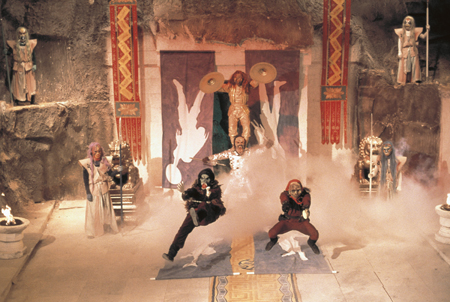 I think this may be the best of the three classic Shaw Brothers movies I’ve seen at Fantasia. Like the other two, this one is fast-paced and wildly inventive. But it struck me that the invention this time out didn’t get in the way of the story quite as much. New ideas are always being introduced, far too quickly to be adequately explored, but the plot seemed to cohere in a way that Demon of the Lute and Buddha’s Palm didn’t, quite. Like them, though, this movie boasts some excellent fight choreography, courtesy of Yuen Tak — who also handled choreography for My Father is a Hero, among others — and Phillip Kwok, who also plays the good guy’s kung fu mentor, The Phantom. A Shaw Brothers regular, Kowk was in Demon of the Lute and choreographed and starred in classics like Five Deadly Venoms and Hard Boiled. Beyond the choreography, the fights are shot and edited well, keeping every move front and centre while pushing a frenetic pace.
I think this may be the best of the three classic Shaw Brothers movies I’ve seen at Fantasia. Like the other two, this one is fast-paced and wildly inventive. But it struck me that the invention this time out didn’t get in the way of the story quite as much. New ideas are always being introduced, far too quickly to be adequately explored, but the plot seemed to cohere in a way that Demon of the Lute and Buddha’s Palm didn’t, quite. Like them, though, this movie boasts some excellent fight choreography, courtesy of Yuen Tak — who also handled choreography for My Father is a Hero, among others — and Phillip Kwok, who also plays the good guy’s kung fu mentor, The Phantom. A Shaw Brothers regular, Kowk was in Demon of the Lute and choreographed and starred in classics like Five Deadly Venoms and Hard Boiled. Beyond the choreography, the fights are shot and edited well, keeping every move front and centre while pushing a frenetic pace.
This is a film that lives in its own highly stylised world. It’s a wild fantasy, yet also one that exists within meticulous conventions; and then again, it stretches those conventions in unexpected ways. If it doesn’t pay much attention to standard ideas of character, maybe that’s because it’s not interested in them and shouldn’t be judged as such. Instead it structures a quest story, quite well, with fight scenes a major component. And on its own terms it makes sense. The feel of magic and adventure is palpable.
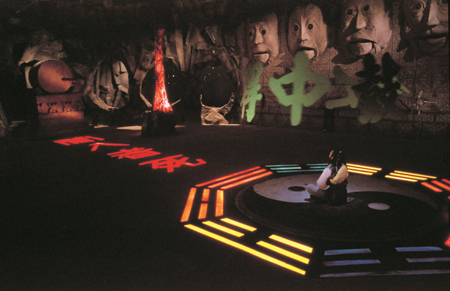 The movie’s also funny, refusing to take itself too seriously even while it strains after the operatic. It’s precisely as entertaining as it wants to be. The violence is as bloodless as a Marvel film, or more so, meaning it’s mostly suitable for youngsters — though some parents might want to be alerted about one scene featuring bas-reliefs of bare breasts. Otherwise sexuality’s not a major component of the film; the martial-arts clan that raises the sister are an all-woman faction dedicated to “virgin swordplay,” meaning they maintain their power only so long as they remain etcetera, but this doesn’t really enter the plot in a significant way.
The movie’s also funny, refusing to take itself too seriously even while it strains after the operatic. It’s precisely as entertaining as it wants to be. The violence is as bloodless as a Marvel film, or more so, meaning it’s mostly suitable for youngsters — though some parents might want to be alerted about one scene featuring bas-reliefs of bare breasts. Otherwise sexuality’s not a major component of the film; the martial-arts clan that raises the sister are an all-woman faction dedicated to “virgin swordplay,” meaning they maintain their power only so long as they remain etcetera, but this doesn’t really enter the plot in a significant way.
I think in the end what makes the film work is the settings it presents, perhaps especially including an Indiana Jones–like cave of traps. There’s a sense of the characters encountering one strange place after another, culminating with a final battle in a haunted graveyard when all the martial-arts techniques and special effects we’ve been introduced to across the film come into play. After which the movie abruptly ends, having conjured up a sense somewhere between myth and Masters of the Universe, leaning rather more to the latter. It’s a movie that aims at pure entertainment, and succeeds admirably.
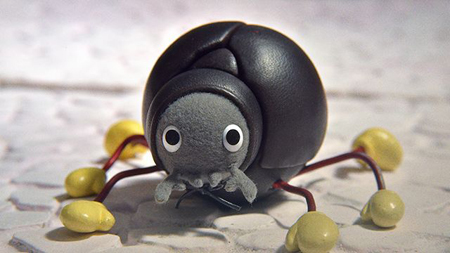 The Fragments of Asia 2016 showcase came next, preceded by a brief presentation by Nicolas Archambault, one of Fantasia’s Directors of Asian Programming, and Rupert Bottenberg, Director of the Axis Section (making him the man responsible for animation programming at Fantasia). They announced that in addition to the six scheduled short films, we’d be able to see a seventh, by that year’s Lifetime Achievement Award–winner, Takashi Miike.
The Fragments of Asia 2016 showcase came next, preceded by a brief presentation by Nicolas Archambault, one of Fantasia’s Directors of Asian Programming, and Rupert Bottenberg, Director of the Axis Section (making him the man responsible for animation programming at Fantasia). They announced that in addition to the six scheduled short films, we’d be able to see a seventh, by that year’s Lifetime Achievement Award–winner, Takashi Miike.
It turned out to be a five-minute stop-motion animated piece, “Keep On Rolling!” (originally “Korogashiya no Pun”). Aimed at children, it’s about a dung beetle with high aims. Bullied, it won’t give up what it wants to do. It’s visually very clever, particularly in finding new spherical things for the beetle to roll, and a pleasure to look at, bright and colourful.
 It was followed by an animated short from Korean director Kim Jin-a, “Report About Death,” (originally, at least according to one site, “Jug-eum Bo-go-seo”) which tonally fit surprisingly well. The report about death is just that, a presentation about death and how human beings experience death. It’s told through animation and infographics, and told with a sense of humour and a bright, cheery narration. The visual sensibility’s very sharp, with bright flat colours and easy-to-understand shapes. You can see paper-like textures in the designs, giving an engaging (if likely artificial) handmade touch to otherwise very precise imagery.
It was followed by an animated short from Korean director Kim Jin-a, “Report About Death,” (originally, at least according to one site, “Jug-eum Bo-go-seo”) which tonally fit surprisingly well. The report about death is just that, a presentation about death and how human beings experience death. It’s told through animation and infographics, and told with a sense of humour and a bright, cheery narration. The visual sensibility’s very sharp, with bright flat colours and easy-to-understand shapes. You can see paper-like textures in the designs, giving an engaging (if likely artificial) handmade touch to otherwise very precise imagery.
I can’t say much depth came out of the report, though it did cover an admirable amount of ground (and the sub-titles I saw had some issues). But the tone was delightful, quick and clever with a surprisingly upbeat soundtrack and some nice play with its icons. The occasional look at an unexpected or unusual aspect of death or burial customs gave the imagery enough heft for the whole thing to work.
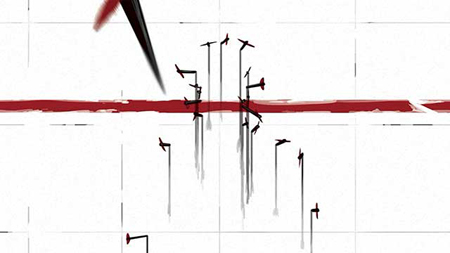 Moving from theory to practice came “I Can See You,” by Korean-trained Chinese director Gu Jie. A man enters a big empty room for the sake of archery practice. But there’s another archer there as well, hiding in the shadows, which the first archer realises when arrows fly at him out of the dark. Desperate, he hunts for shelter and tries to shoot back. The two archers engage in an extended game of cat-and-mouse, each trying to kill the other. The conclusion’s a little underwhelming, but it’s a great ride getting there.
Moving from theory to practice came “I Can See You,” by Korean-trained Chinese director Gu Jie. A man enters a big empty room for the sake of archery practice. But there’s another archer there as well, hiding in the shadows, which the first archer realises when arrows fly at him out of the dark. Desperate, he hunts for shelter and tries to shoot back. The two archers engage in an extended game of cat-and-mouse, each trying to kill the other. The conclusion’s a little underwhelming, but it’s a great ride getting there.
Told in sketch-like pen lines, black and white with splashes of red, the look of the thing is engaging and the motion’s swift and smooth. This works marvellously with the speed of arrows in flight. The short is one nice idea after another — visual ideas showing the impact of arrows or the tension of the one character we see; and action ideas presenting one clever stunt after another with bow and arrow as two archers engage in a run-and-gun (or run-and-bow) duel. As you’d expect from the title, there’s much play with the lighting, which cranks up the suspense. It’s a fine action piece.
 “Retriever,” (or “An-nae-gyeon”) directed by Kim Joo-hwan, is an entirely different movie. A live-action 25-minute piece, it’s a tearjerker and a heartbreaker, dealing with an unemployed immigrant man in Seoul who steals dogs from an animal shelter to sell them for their meat. Then things go awry when one poor animal doesn’t have enough meat on its bones to make the deal worthwhile. The beggar ends up forming an unlikely partnership with the beast. But, tragically, the story doesn’t end there.
“Retriever,” (or “An-nae-gyeon”) directed by Kim Joo-hwan, is an entirely different movie. A live-action 25-minute piece, it’s a tearjerker and a heartbreaker, dealing with an unemployed immigrant man in Seoul who steals dogs from an animal shelter to sell them for their meat. Then things go awry when one poor animal doesn’t have enough meat on its bones to make the deal worthwhile. The beggar ends up forming an unlikely partnership with the beast. But, tragically, the story doesn’t end there.
It’s well-written and well-acted; I can’t find full credits online in English, but I think Moon Sun-Yong stars as Lee Kwang, an ethnic Korean from China. There’s an almost unforgiving sense of a character arc, as he grows and changes through both the good and the bad (note that there are no genre elements in this film) and a sense of impending tragedy. It’s very well-shot, as well, with rich compositions and colours. This is an unyielding story, but remarkably well-told.
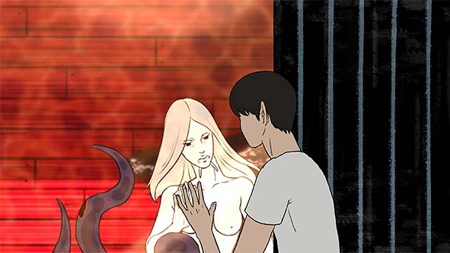 “Throttled,” (or “Mu-jeo-gaeng”) by Korea’s Kim Je-hyon, is a 13-minute animated story about a fisherman who captures a mermaid. By a fluke of scheduling (as it were), this was the third mermaid film I saw at Fantasia, after The Lure and Kaitlin Tinker’s short “The Man Who Captured a Mermaid”. It is by far the most traditional, though the ending you see coming goes farther than you might expect. It’s essentially a horror piece, as the fisherman grows more fascinated by his catch and exploits her further and further until things take an unexpected turn or two.
“Throttled,” (or “Mu-jeo-gaeng”) by Korea’s Kim Je-hyon, is a 13-minute animated story about a fisherman who captures a mermaid. By a fluke of scheduling (as it were), this was the third mermaid film I saw at Fantasia, after The Lure and Kaitlin Tinker’s short “The Man Who Captured a Mermaid”. It is by far the most traditional, though the ending you see coming goes farther than you might expect. It’s essentially a horror piece, as the fisherman grows more fascinated by his catch and exploits her further and further until things take an unexpected turn or two.
There’s no dialogue, which probably helps the folktale-like feel. The animation’s colourful, with mainly simple designs. We hardly ever see the fisherman’s full face, which works in two oddly opposite ways — both making him more sinister and making him more of a point-of-view character. We don’t see his eyes because we’re looking through them.
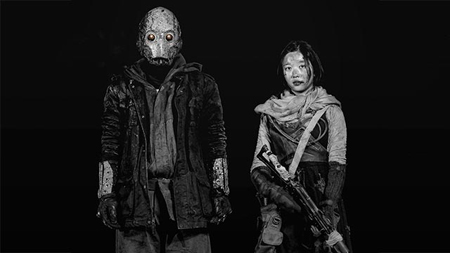 Another Korean movie, “Keep Going” (“Meom-Chu-ji Ma”) is a 20-minute live-action piece from Kim Geong. A quick infodump sets up the post-apocalyptic setting: war robots took part in a devastating war, and now are feared and hated. But one robot, Margo, keeps a girl, Yeon-hee (Choi Bae-young), alive through an extended umbilical cord that connects them and keeps Yeon-hee’s heart beating. Together they wander into a bad place, face an ambush by violent robot-haters, and the story explodes with action.
Another Korean movie, “Keep Going” (“Meom-Chu-ji Ma”) is a 20-minute live-action piece from Kim Geong. A quick infodump sets up the post-apocalyptic setting: war robots took part in a devastating war, and now are feared and hated. But one robot, Margo, keeps a girl, Yeon-hee (Choi Bae-young), alive through an extended umbilical cord that connects them and keeps Yeon-hee’s heart beating. Together they wander into a bad place, face an ambush by violent robot-haters, and the story explodes with action.
There are themes here of family and attachment, but I’d say for me they tended to be outweighed rather than sharpened by the action element. Luckily, the action cinematography is top-notch. The sets are well-chosen and well-decorated to create the feel of a bombed-out world, and the characters are moved through the settings cleverly as part of the extended shoot-out that dominates much of the film. The movie reaches a solid ending point, but leaves open a hint that there’s more story to come — more than a hint, in fact, as it ends by inviting viewers to the movie’s Facebook page, where they can find an 18-page prequel comic.
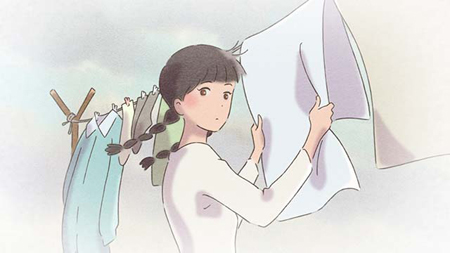 Finally came the directorial debut of Yoshimi Itazu, chief animator of Miss Hokusai. “Pigtails,” written by Miho Maruo and adapted from Machiko Kyo’s manga Mitsuami no Kami-sama, opens with quarreling clothespegs, before widening out to show that the pegs are only implements being casually used by a girl living on her own in a shack in a wasteland. Some catastrophe happened in the past; now, here, she’s visited and given routine medical check-ups by mysterious men. And then a boy finds his way to her one time after the men leave. They grow close, wonder about the world around them, and the boy in particular explores to the limits of their world. What they learn leads them to seek escape — but will they stick to that desire? Or are there higher issues at stake?
Finally came the directorial debut of Yoshimi Itazu, chief animator of Miss Hokusai. “Pigtails,” written by Miho Maruo and adapted from Machiko Kyo’s manga Mitsuami no Kami-sama, opens with quarreling clothespegs, before widening out to show that the pegs are only implements being casually used by a girl living on her own in a shack in a wasteland. Some catastrophe happened in the past; now, here, she’s visited and given routine medical check-ups by mysterious men. And then a boy finds his way to her one time after the men leave. They grow close, wonder about the world around them, and the boy in particular explores to the limits of their world. What they learn leads them to seek escape — but will they stick to that desire? Or are there higher issues at stake?
The animation is quietly spectacular, like delicate watercolour paintings come to life. Designs are homely, deliberately evoking a simple domestic life, in contrast with what we eventually find out is going on. The story is meditative, delicate, and impossible to predict. It unfolds in deeply unexpected ways, broadening out and shifting genres. It all coheres nicely, but I found myself delightfully wrong-footed as the story went on. The tendency of inanimate objects to talk while around the main character, for example, turns out not to be what the plot of the film’s about; but it is something that’s symbolically appropriate. This is a film with dreamlike imagery, and ideas that drive them.
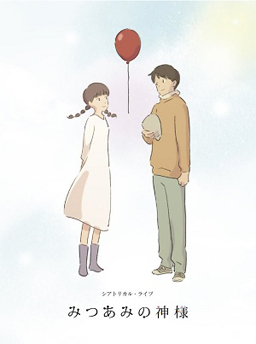 I would say that more specifically “Pigtails” is a meditation on escape and duty, on happiness and on what gives life meaning. It’s less a typical bildungsroman and more a story of young people facing a choice about how to live in the world around them. “Things exist to be used by people — but people?” one of the characters reflects near the end. It sounds banal, but in context you understand that it’s posing what is after all one of the big questions: what is the point of a person’s life? And it’s doing so in a language naturally set up by the symbols of the rest of the film. This is a movie about thingness, about the life in things and about people using people as things — and whether there can be a value in that. In many ways it’s a disturbing story, as I presume it was intended to be.
I would say that more specifically “Pigtails” is a meditation on escape and duty, on happiness and on what gives life meaning. It’s less a typical bildungsroman and more a story of young people facing a choice about how to live in the world around them. “Things exist to be used by people — but people?” one of the characters reflects near the end. It sounds banal, but in context you understand that it’s posing what is after all one of the big questions: what is the point of a person’s life? And it’s doing so in a language naturally set up by the symbols of the rest of the film. This is a movie about thingness, about the life in things and about people using people as things — and whether there can be a value in that. In many ways it’s a disturbing story, as I presume it was intended to be.
Between Holy Flame and Fragments of Asia it was a good start to the day, if all over the map tonally. I’d seen several well-told stories, most of them genre pieces. Beginning with a direct action-comedy I’d seen a set of increasingly-complex films, ending with what turned out to be a kind of dreamlike dystopia. I hoped the next two movies would be able to match the first half of the day.
(You can find links to all my Fantasia 2016 diaries here.)
Matthew David Surridge is the author of “The Word of Azrael,” from Black Gate 14. You can buy his first collection of essays, looking at some fantasy novels of the twenty-first century, here. His second collection, looking at some fantasy from the twentieth century, is here. You can find him on Facebook, or follow his Twitter account, Fell_Gard.